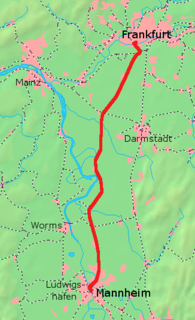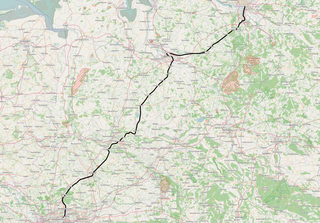
Frankfurt am Main Airport long-distance station is a railway station at Frankfurt Airport in Frankfurt, Germany. It is served by long-distance trains, mostly ICE services running on the Cologne–Frankfurt high-speed rail line. It is the largest railway station serving an airport in Germany with about 23,000 passengers each day. The station is served by 210 long-distance trains daily, of which 185 are Intercity-Expresses. It and Limburg Süd Station are the only railway stations in Germany that are served exclusively by long-distance trains.

The New Pendolino is a class of high-speed tilting trains built by Alstom Ferroviaria for Trenitalia, SBB, Renfe, and PKP, known as the ETR 600 / 610, RABe 503, Avant S-114 and ED250 respectively. They represent a further development of the earlier Pendolino models in order to better respond to the requirements expressed by the market and the customers of Trenitalia and Cisalpino.

The TGV Duplex is a French high-speed train of the TGV family, manufactured by Alstom, and operated by the French national railway company SNCF. It is unique among TGV trains in that it features bi-level carriages. The Duplex inaugurated the third generation of TGV trainsets. It was specially designed to increase capacity on high-speed lines with saturated traffic. With two seating levels and a seating capacity of 508 passengers, the Duplex increases the passenger capacity. While the TGV Duplex started as a small component of the TGV fleet, it has become one of the system's workhorses.

The ICE 1 is the first batch-produced German high-speed train and one of six in the Intercity-Express family. Revenue service at speeds up to 250 km/h (155.3 mph) started in 1991. It was raised to 280 km/h (174.0 mph) in May 1995 and later reduced to 250 km/h (155.3 mph) again. Today, only a handful of ICE 1 services on the Nuremberg–Munich high-speed railway reach 280 km/h (174.0 mph).

The Hanover–Würzburg high-speed railway was the first of several high-speed railway lines for InterCityExpress traffic that were built in Germany. While technically starting in the village of Rethen and ending several kilometres north of Würzburg Hauptbahnhof, it is a de facto link between Hanover and Würzburg, with stops at Göttingen, Kassel, and Fulda. Early construction started in 1973, the line opening fully in 1991.

Würzburg Hauptbahnhof is a railway station for the city of Würzburg in the German state of Bavaria. It was opened in 1864 to the north of the inner city as a replacement for the former Ludwigsbahnhof in the city centre, the capacity of which had been exhausted by the dramatic increase of rail traffic. Even today, Würzburg station is one of the major stations in Bavaria, since it lies at the intersection of several heavily used rail corridors. In particular, the routes in the north–south direction from Hamburg and Bremen to Munich as well as in west–east direction from the Rhine-Ruhr and Rhine-Main to Nuremberg and Vienna. Apart from Aschaffenburg Hauptbahnhof, Würzburg is the only station in Lower Franconia to be served by Intercity-Express services. With its combination of rail, tram and bus services, the station is the main hub for public transport in the city and the district of Würzburg.

The Cologne–Aachen high-speed line is the German part of the Trans-European transport networks project high-speed line Paris–Brussels–Cologne. It is not a newly built railway line, but a project to upgrade the existing railway line which was opened in 1841 by the Rhenish Railway Company. When it was continued into Belgium in 1843, it became the world's first international railway line.

The DR Class 243 is a universal electric locomotive of the Deutsche Reichsbahn which is used for general rail service. Deutsche Bahn lists the locomotive as Class 143. The locomotives of class 143/243 still belong to the most successful class of German electric locomotives.

Mannheim–Frankfurt railway is a German standard gauge, electrified railway line and runs in southern Hesse and northern Baden-Württemberg between Frankfurt and Mannheim. It is also called the Riedbahn. The line runs through an area called the Hessische Ried, hence the name. The term Riedbahn was originally used for the Darmstadt–Worms railway and the two lines share the central section between Groß-Gerau and Biblis.

The Polish railways network consists of around 18,510 kilometres (11,500 mi) of track as of 2015, of which the vast majority is electrified at 3 kV DC overhead.

The Main-Spessart Railway is a 110 kilometre long railway line in the Bavarian province of Lower Franconia and the neighbouring state of Hesse in south central Germany. It runs from Würzburg via Gemünden (Main) and Aschaffenburg to Hanau. It is particularly important for long-distance and goods traffic because it links the Rhine-Main conurbation immediately northwest of Aschaffenburg with the Lower Franconian city of Würzburg and beyond it to the metropoles of Nuremberg and Munich. Its name derives from the fact that it initially runs parallel to the River Main and then cuts through the Spessart hills. It was opened on 22 June 1854 by the Frankfurt-Hanau Railway Company and is one of the oldest railways in Germany

The Wanne-Eickel–Hamburg railway is the shortest railway link between the Ruhr and the Hamburg Metropolitan Region and hence one of the most important railway lines in northwest Germany. It links the cities of Münster (Westfalen), Osnabrück and Bremen.

128 001, as registered at Deutsche Bahn, or 12X, as named by its manufacturer AEG Schienenfahrzeuge and its successive owners ADtranz and Bombardier Transportation, is an experimental high-performance electric locomotive built in 1994, which was operated as testbed and test locomotive until 2010. The design of the locomotive featured several technological innovations, including power electronics using new types of semiconductors and water cooling, a new final drive concept, a new bogie concept, and protruding windflaps for improved aerodynamics that gave the locomotive a unique look.

The Fulda–Hanau railway is a double track and electrified main line in the German state of Hesse. It runs south from Fulda along a ridge and then through the valley of the Kinzig to Hanau. As a result, it is also known as the Kinzig Valley Railway.
The Hanover–Minden railway is one of the most important railways in Lower Saxony and railway in Germany. It connects the capital of Lower Saxony, Hanover via Wunstorf, Stadthagen and Bückeburg with Minden, Osnabrück, Amsterdam and the Ruhr.

The Nuremberg–Würzburg Railway is a German trunk line railway in northern Bavaria, connecting the city of Nuremberg with Würzburg, the two largest cities in Franconia, and passing through Fürth, Neustadt an der Aisch and Kitzingen. In addition to hourly Regional-Express trains and numerous freight trains, it is served by Intercity-Express trains during the day at half-hourly intervals with some gaps.

The Nuremberg–Augsburg railway is a 137 km long main line in the German state of Bavaria. Most of it follows two parts the historic Ludwig South-North Railway, one of the oldest lines in Germany. Today, even after the opening of the high-speed line from Nuremberg to Munich via Ingolstadt, is still used for long distance services. It is also used as a detour during closures of the high speed line for maintenance. Between Nuremberg and Roth S-Bahn services run on the parallel Nuremberg–Roth line.

Gütersloh Hauptbahnhof is the main railway station in Gütersloh in the German state of North Rhine-Westphalia. It is on the electrified, four-track main line from the Ruhr to Hanover, opened in 1847 as part of the trunk line of the former Cologne-Minden Railway Company. Services of the Warendorf Railway also run from Münster via Rheda-Wiedenbrück and the Hamm–Minden line to Gütersloh.
The Breckenheim–Wiesbaden railway is a 13-kilometre (8.1 mi) long railway line in the vicinity of the Hessian state capital of Wiesbaden. It connects the Cologne–Frankfurt high-speed rail line with Wiesbaden Central Station.































